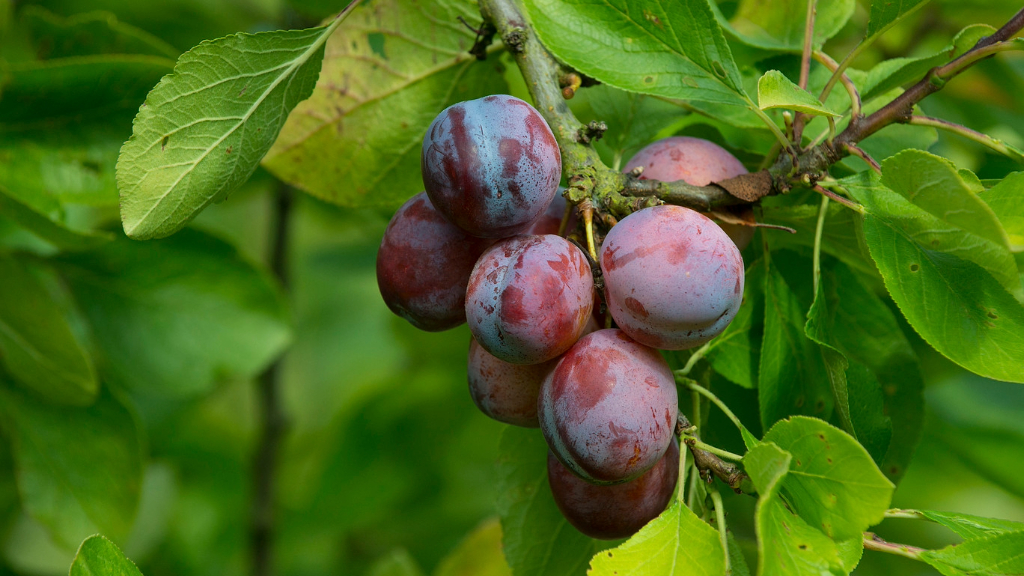Top 10 Questions About Plum Trees


Here at Gardening Know How we get lots of questions, and our goal is to provide answers to those inquiries to the best of our knowledge. Plums are one of summer's great pleasures and growing them yourself gives easy access to the freshest and juiciest of the season. Plum trees usually thrive without much babying but they are prey to many pests and diseases that can affect foliage, stems or fruit. The following information includes the 10 most commonly asked questions about plum trees. 1. What to do for leaf curl on plum trees? Plum tree leaf curl is common on many species of this stone fruit. It is caused by aphid feeding behavior. The insect sucks plant sap and transmits a chemical that causes cells to malform, distorting the leaves. If you were to open a curled leaf, you would likely spot the culprits - tiny, shiny greenish-brown to greenish-yellow insects. They are most vigorous in spring where their feeding damage can encompass just a stem or many parts of the plant. Encourage predatory insects, spray with neem oil or hand pick the affected leaves and pests 2. Why is there no fruit on my plum tree? Age might be one concern. Plum trees don't fruit until they are between 3 and 6 years of age. Plums also need a co-pollinator to set fruit. Another plum needs to be near enough so that wind and insect pollination can take place. Temperatures are another possible cause. An inadequately cold winter or a late freeze that kills flowers can all prevent fruiting. Excess nitrogen can cause the formation of leaves over buds, reducing the fruit population. Finally, while it may seem obvious, pruning at the wrong time can sacrifice your fruit crop. Avoid terminal pruning and take stems back to their origination of growth to promote flowering. 3. Why is my plum tree oozing sap? Plum trees that leak sap could have an insect, disease, mechanical injury or even sunscald. Common insects like borers tunnel into the tree, creating a hole that will ooze sap. Cytospora canker or certain bacterial diseases cause lesions to form, which bleed sap. Watch where you trim with that weed wacker, as injuries to the trunk invite pest or disease problems and will ooze sap. A common problem on young trees, sunscald burns the stems or trunk of the plant, causing oozing scabby spots. Create adequate shade for trees in hot, dry areas or where sun reflected off snow will sear the plant material. 4. What makes plums shrivel up on the tree? French and Italian plums are susceptible to a disease called plum pocket. It can cause the loss of up to 50 percent of the fruit on a tree if left untreated. The culprit is a fungus that distorts foliage and leaves behind sunken, malformed fruit. Apply fungicides early in the season to prevent the disease or plant disease resistant cultivars. Another possible reason for shriveled fruit is brown rot plum disease. It is another fungus that produced mummified mature fruit. Other symptoms are cankers on twigs, spotted fruit, spores on fruit, brown wilted flowers that may ooze nectar. 5. How come the leaves are turning red on my plum tree? If you don't have a cherry plum, purple leaf plum or flowering species, which normally have richly burgundy leaves, then red leaves on your plum may indicate a disease. The culprits are almost endless, unfortunately, but the most common are rust, bacterial leaf spot, Coryneum blight, or Phytophthora root rot. Rust is a fungal issue where leaves develop yellow spots with red undersides. Bacterial leaf spot begins with dark circular spots that age to a reddish tone. Small red spots develop with Coryneum blight and Phytophthora causes reddish leaves, oozing sap and dark spots on bark. All of these may be combated with fungal sprays. 6. When to spray a plum tree for insects? Spraying your fruit trees is an essential part of maintenance. The spray schedule differs dependent upon the stage in which the tree is developing. Dormant oils should be sprayed at bud swell, in late winter to early spring. These are usually Bordeaux mixtures or horticultural oils. At budding time, just before the flowers open but when the buds are beginning to color, use an insecticidal soap to prevent pests. Once the flowers are open, do not apply insecticides, as they can kill important pollinators and cheat you of a fruit crop. 7. Can I grow plum tree seeds? Most commercial fruits are developed from a rootstock. This promotes certain traits and ensures a fruit that is the same as the parent plant in the scion. Plants that are not grafted in this way will grow just fine, but the appearance of the tree and the flavor of the fruit can be quite different in seeded plants. That being said, you can plant a plum pit with a little pre-preparation. Scrub off the pulp, dry the seed and put it in the refrigerator for 6 to 8 weeks. This will break the embryo's dormancy. You may also choose to plant the seed outdoors in fall where it will receive the cold treatment naturally. Place the pit 3 inches (8 cm.) deep, covered with soil. Indoor plants may be started in a mixture of vermiculite and potting soil, lightly moistened. Keep plants damp once sprouting occurs. 8. Leaves are dropping from my tree, why? Plants drop leaves for a variety of reasons. Cultural or environmental considerations are often the culprit. Low moisture or nutrients, inadequate light, low pH, or even weather damage may all cause leaf drop in plums out of season. If new leaves form and the plant re-foliates quickly, it usually causes no harmful effects to the tree. The problem can also stem from disease or pest infestations. The best way to tell is to look for other symptoms. Do you see bugs or are leaves ragged, have holes and exhibit signs of sucking or chewing? Are there any cankers, bolt holes, speckling or other symptoms of disease or pests? Good cultural care and an appropriate organic spray routine that begins in late winter or very early spring and continues until flowers open will usually set the plant right. 9. When should you pick plums? Your senses of touch and taste are the best gauge of the right time to pick fruit. Each variety of plum ripens at a different time of year and that varies by zone as well. If the fruit is slightly soft with just a little pressure from your fingers, it is likely ready. You can taste test one to determine if the amount of give is the correct amount for good flavor. Color is another way to judge when to harvest plums. Plums vary in color from deeply purple, to bluish violet, yellow and even red. Know what variety you have planted and what color the ripe fruit should be. Ripe fruits will also twist easily off the tree. The petiole will become fragile as the fruit matures and should easily pull off the plant. 10. When and how to prune a plum tree? Young trees need annual pruning to develop an open shape and good scaffold. New trees need to be cut to knee height with the cut just above a bud in early spring before bud break. In the second year, cut the main leader 18 inches (46 cm.) above a healthy bud. Leave three branches below this cut that radiate out evenly. Cut these back to 10 inches (25 cm.) from their origin. The idea is to promote a vase-like shape. Prune established trees in mid-summer. Remove weak, broken or diseased limbs as well as any that cross or grow straight up - water spouts. Head back lateral limbs as needed, but always cut back to a bud that is aimed in the direction you want new plant material to grow. Trim side shoots to six leaves from the originating wood to encourage fruiting. We all have questions now and then, whether long-time gardeners or those just starting out. So if you have a gardening question, get a gardening answer. We're always here to help.
Sign up for the Gardening Know How newsletter today and receive a free copy of our e-book "How to Grow Delicious Tomatoes".
